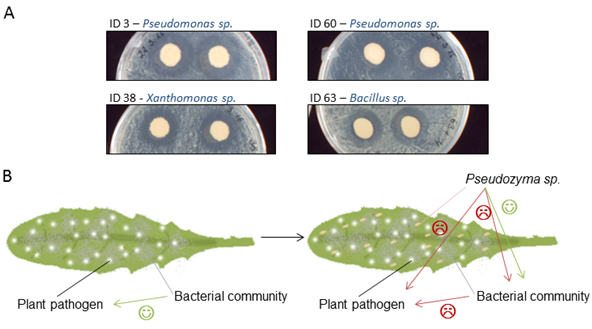Which factors are needed to shape a microbial leaf community?
Plants are an important habitat for various microorganisms like bacteria, yeasts, filamentous fungi, protists, and archaea that influence the plants growth and fitness. They can for example directly help to take up nutrients from the soil and thereby help the plant to be more competitive. In addition, they show the interesting ability to protect the plant from its herbivores or other microbial pathogens. In CEPLAS Research Area C, we want to characterize the structure, function, and ecology of the root and leaf microbiome. This particular field of research has a high importance for agricultural use: Instead of using pesticides and other environmental harmful substances, we could understand how plants can be protected naturally against their enemies, engineer synthetic microbial communities that can be sprayed onto the plants and help them to cope with different pests.
In previous studies at the Max-Planck Institute for Plant Breeding Research, a basidiomycete yeast was isolated and identified as an uncharacterized Pseudozyma subspecies. Pseudozyma spp. belong to the family of Ustilaginomycetes and are closely related to the genus Ustilago, a well-studied family of pathogens whose members can infect agricultural important grasses like maize and barley. Particularly, it seems to be that Pseudozyma ssp. have an important function in plant protection against pathogens in contrast to the pestilent Ustilago and can help us understand what factors are needed to shape the leaf microbiome.

Some Pseudozyma subspecies are known to produce glycolipid biosurfactants, which can interfere with the microbial cell membrane and thereby negatively influence their growth. This can cause drastic changes in the appearance of the microbiome and thus the plants metabolism.
Of additional interest to us is its close relationship to the Ustilago pathogens. We know from plant-pathogen studies that Ustilago can directly influence the metabolism of its host by secreting proteins – so called effectors. These proteins are needed during plant infection to overcome the plants immune system and to be able to infect the plant. But from almost 400 as potential effectors predicted proteins only few are characterized by now!
In my project, we propose that effector proteins are also of importance for the influence of microbial dynamics on the leaf and for establishment of an own ecological niche. To prove this concept, we will identify genes from the identified Pseudozyma subspecies in this project that are switched on during cultivation together with bacterial members of the Arabidopsis leaf microbiome. Thus, we will contribute to the understanding of which factors are needed to influence a microbial community and how this can be used to engineer synthetic communities.
Katharina Lentz, Institute of Botany, Chair of Terrestrial Microbiology, University of Cologne
Planter’s Punch
Under the heading Planter’s Punch we present each month one special aspect of the CEPLAS research programme. All contributions are prepared by our young researchers.
Further Reading
Buxdorf, K., et al. (2013). "The epiphytic fungus Pseudozyma aphidis induces jasmonic acid- and salicylic acid/nonexpressor of PR1-independent local and systemic resistance." Plant Physiol 161(4): 2014-2022 [Abstract]
Hammami, W., et al. (2011). "Ecological basis of the interaction between Pseudozyma flocculosa and powdery mildew fungi." Appl Environ Microbiol 77(3): 926-933. [Abstract]
About the author

The article was written by Katharina Lentz, who is a member of the CEPLAS Graduate School. In the frame of her PhD thesis, Katharina is analysing the the influence of the bacteria Pseudomonas sp. regarding microbial dynamics on the leaf and for the establishment of an own ecological niche.